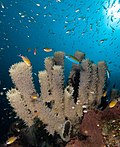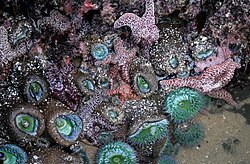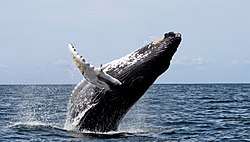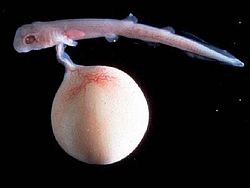Marine biology
Marine biology is the study of any living plant or animal in the sea. Marine biologists study it. Like other scientists, marine biologists must know a lot about the creatures they are studying. They also must understand how the sea works. The study of how the sea works is oceanography.
Marine animals include squids, corals, whales and fish. Marine plants include sea grasses and algae. The Census of Marine Life was a ten-year project of marine biology. Like land animals, marine animals have been evolving for hundreds of millions of years, [1] thus trilobites and ammonites are no more, but now there are whales. Biologists also study animal behavior.
A marine biologist needs a bachelor's degree in biology, followed by at least an MSc in marine biology. The ocean is large and marine biologists work in many subfields like invertebrate zoology, ichthyology, and physiology. Others study physical traits like scales, eyes, or shells.
History
During the Age of Discovery many ships sailed far from home. Captain James Cook went twice around the world and discovered new places. Another person who helped is Charles Darwin, known for the Theory of Evolution. He worked in marine biology. His expeditions aboard the HMS Beagle from 1831–1836 collected marine organisms. Several other people also made important voyages. Alfred Russel Wallace spent much of his younger life travelling the world and recording the plants and animals he saw.
Marine Biology Media
Marine biology studies species that live in marine habitats. Most of the Earth's surface is covered by ocean, which is the home to marine life. Oceans average nearly four kilometers in-depth and are fringed with coastlines that run for about 360,000 kilometres.
Coral reefs provide marine habitats for tube sponges, which in turn become marine habitats for fish
Tide pools with sea stars and sea anemone
Coral reefs form complex marine ecosystems with tremendous biodiversity.
Some representative ocean animal life (not drawn to scale) within their approximate depth-defined ecological habitats. Marine microorganisms exist on the surfaces and within the tissues and organs of the diverse life inhabiting the ocean, across all ocean habitats.
The open ocean is the area of deep sea beyond the continental shelves.
A deep-sea chimaera. Its snout is covered with tiny pores capable of detecting animals by perturbations in electric fields.
HMS Challenger during its pioneer expedition of 1872–1876
References
- ↑ Benton M.J. 1990. The reign of the reptiles. ISBN 0-517-02557-4
Other websites
| Wikimedia Commons has media related to Lua error in Module:Commons_link at line 62: attempt to index field 'wikibase' (a nil value).. |
- What is a marine biologist? -Careers
- What is marine biology? Archived 2019-05-23 at the Wayback Machine -University of Texas
- Marine biology -Citizendium









